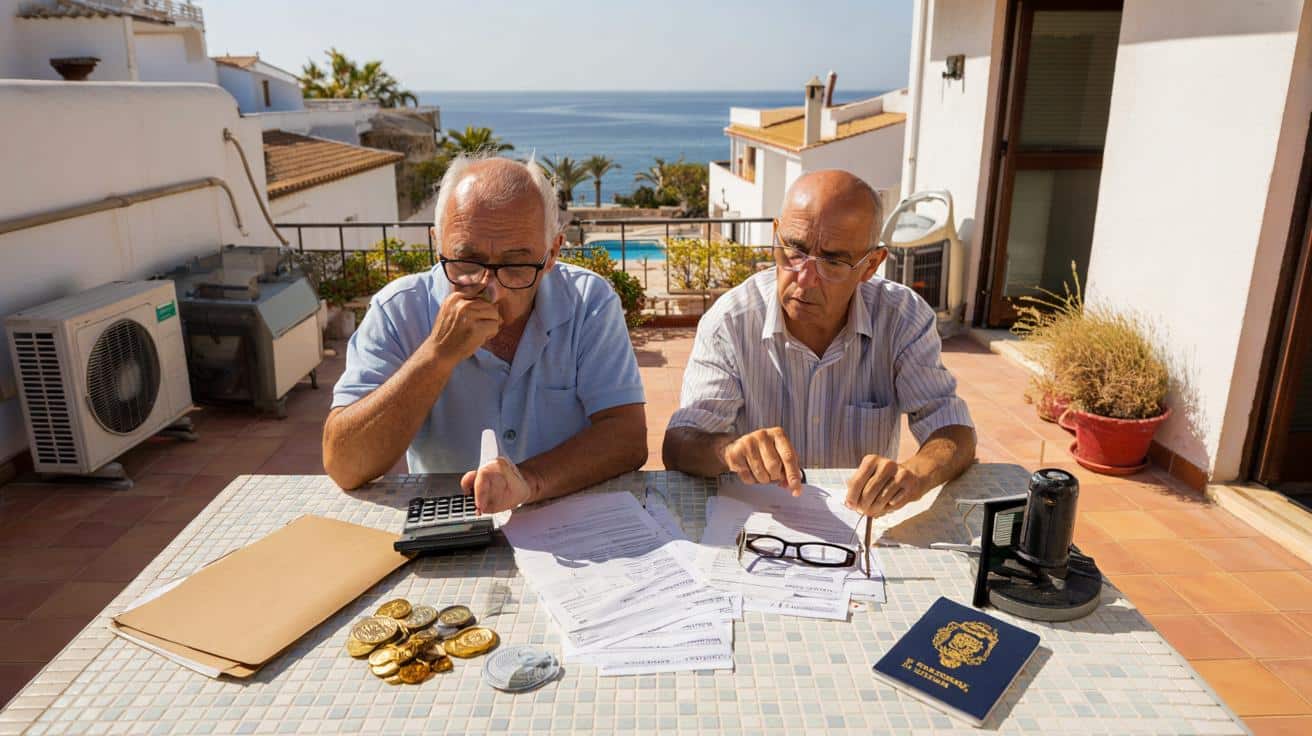They sell the dream as if it’s lazy afternoons and cheap tapas on tap. The reality: sunny days come with fine print in euros, stamps, and small fees that nibble at your budget until you feel it. Spain is gorgeous — and pricier than you think in the places that lure you in.
Beyond the glass, an elderly couple argued about whether to fit air con in the guest room, their voices soft but urgent. I’d come to sign for a modest flat near the coast, convinced I’d cracked the maths of an affordable retirement. The sea was right there. Blue, uncomplicated, seductive.
Then a folder hit the desk with a polite thud: notary fees, registry charges, “gestor” services, community costs, local taxes. None of it hidden, exactly. Just scattered across new words and unfamiliar stamps. I smiled anyway. What’s a few hundred here and there when you’ve already moved your life?
That was the day I learnt that costs in Spain arrive like waves. Gentle at first. Relentless in the end.
The costs nobody puts on the postcard
You hear it constantly: Spain is cheaper than Britain. Groceries can be, and a menu del día still feels like a small miracle. Then summer slams in, the air turns syrupy, and your electricity bill doubles because the air con hums at night. Winter sneaks up, too. In older flats the chill gets into your bones — the radiators don’t always save you.
Property taxes sound light until you meet them in the flesh. IBI (council tax equivalent), basura (rubbish), and that tidy monthly “comunidad” for lifts, pools, gardeners you rarely see. A friend in Alicante pays more to maintain a shared pool than he ever imagined using it. He shrugged the first year. By year three it stopped feeling cute.
If you’re British and resident, healthcare can be a maze. Many retirees use the S1 route into public care, which helps. Plenty still pay for top-up cover, faster appointments, or dentistry. And those who aimed for a non-lucrative visa first discovered private health insurance has rules — comprehensive, no co-pays — and premiums that climb with age. The maths slips, quietly.
When “cheap” depends on the small print
Buying isn’t just a handshake and a cork popped on a terrace. It’s a procession: notary, registry, transfer tax, and often a “gestor” to herd the papers through. That last bit sounds optional until you try to decode a tax model at midnight. My first year, I paid twice what I’d planned in fees, partly out of fear of getting it wrong. I slept better. I also ate more sardines than steak.
We’ve all had that moment when a bank fee lands and you don’t know what it’s for. Spanish banks love maintenance charges, card fees, and transfer costs with merry little names. A neighbour thought he’d scored a bargain on a second-hand car, then spent weeks paying for the right plates, new insurance, and the ITV roadworthiness test. It still beats UK prices in many cases. It just refuses to be simple.
Taxes catch you sideways. Rent out a place for a few weeks a year and the tax man wants a word. Don’t rent it at all and there can still be an imputed income tax for non-residents. Move your pension into Spain and some streams are taxed here, not there. Wealth taxes exist, differ by region, and are wrapped in exceptions that sound like folklore. You don’t need to be rich to feel the drafts.
How to stop the drift and keep your budget honest
Build a “sunshine buffer”. A separate pot for heat, cooling, and water quirks. In summer, run air con on timers and nudge the thermostat up a notch — comfort without the burn. In winter, heat rooms you live in, not corridors you pass through. Swap to LED bulbs. Install awnings or shutters that actually get used. *It’s not glamorous, but neither is a surprise €240 bill in August.*
Pick your region with your calculator, not your heart. Some areas have higher community fees, pricier bins, or steeper transfer taxes. A town inland can halve your housing cost while keeping you 25 minutes from the beach. Ask neighbours what they really pay. They’ll tell you more, and faster, than the glossy brochures. Let’s be honest: nobody does that every day.
“Spain is affordable if you live like Spain, not like a tourist who never went home,” a retired nurse in Málaga told me. “I learned the hard way, then it was fine.”
- Audit your bank: switch to low-fee accounts; use a currency transfer service for pensions and savings.
- Track “quiet” charges: community fees, rubbish tax, gestor, notary, registry, ITV, driving licence swaps.
- Lean on the S1 route if eligible; price private cover early if not.
- Plan for taxes region by region — and budget for a tax adviser, at least the first year.
What nobody told me until the bill came
The internet in my block was fine until summer, when holiday lets multiplied and the bandwidth sulked. I paid for a better line. The lift failed twice in a season and our comunidad fee ticked up to fund repairs. A drought notice arrived and we started paying extra for water, which made the lush communal lawn feel like a joke I was footing.
Then there were the small rituals that cost. Every photocopy stamped. Every certificate translated. Appointments that need a gestor because the portal hates your passport format. None of it dramatic. All of it cumulative. **The sunshine isn’t free; it’s paid in coins of convenience and clarity.**
Some days I miss the ease of a British kettle and a single council bill. Most days, I look at the light on the tiles and think: worth it. The trick is to treat the dream like a budget line, not a miracle. **Spain rewards the prepared, not just the optimistic.**
What this really means for your plans
If you’re counting on “Spain is cheap” to carry the day, you’ll feel every hidden fee like gravel under your sandals. Better to build your life here around the way locals actually live: seasonal rhythms, patience with paperwork, long lunches at home rather than constant eating out. The difference between a strained budget and a steady one is rarely a single big bill. It’s the ongoing choreography of small ones.
That doesn’t kill the dream. It makes it sturdier. Spain asks for attention — to where you live, how you cool and heat, which bank you choose, what your visa truly requires. Get that right and the numbers soften. Your mornings get quiet. Your evenings stretch. The sea remains the sea.
There’s a cost to moving here, and there’s a cost to staying put and wishing you had. **Only one of those comes with oranges and a neighbour who calls you by name.**
| Point clé | Détail | Intérêt pour le lecteur |
|---|---|---|
| Hidden home costs | IBI, basura, community fees, notary/registry, gestor | Spot the real annual spend beyond the listing price |
| Utilities swing | Air con in summer, heating in winter, water during droughts | Prevents bill shock with a “sunshine buffer” |
| Visa and health puzzle | S1 access, private cover rules, older-age premiums | Choose the right path and avoid expensive detours |
FAQ :
- Is Spain still cheaper than the UK for retirees?Often for food and rent outside hotspots, yes. Add utilities, community fees, and admin and the gap narrows fast.
- What’s the typical monthly “comunidad” fee?Anywhere from €30 to €200+, depending on lifts, pools, gardens, and building age. Ask for last year’s minutes.
- Do I need private health insurance?If you’re not covered by an S1, expect comprehensive, no-copay cover for certain visas — and rising premiums with age.
- How big should my buffer be?Many retirees ring-fence 10–20% of living costs for the unexpected: utilities spikes, repairs, paperwork.
- What are the sneakiest bank costs?Account maintenance, card fees, and currency transfer spreads. Use low-fee accounts and specialist FX services.









For the non‑lucrative visa, are insurers still insisting on comprehensive, no‑copay policies? Any ballpark for premiums at 65, 70, 75? Trying to model this before I jump.
This reads like a coastal-hotspot problem. Go 20–30 minutes inland and costs drop—IBI, comunidad, even rent. Spain is affordable if you don’t live like a tourist 24/7. Definately needs that nuance.